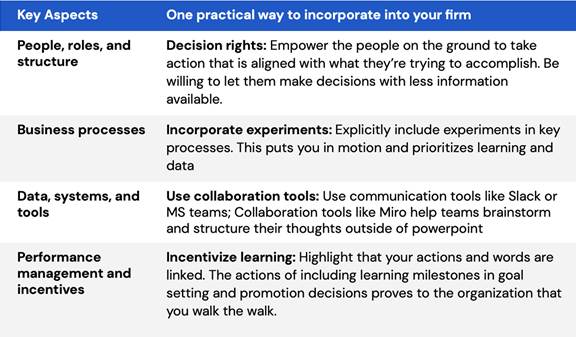COVID-19 has thrown the world into a state of flux. Our governments, businesses, and families are undergoing complete upheavals of our once normal routines. Firms of all sizes are now faced with tough decisions that will impact their survival and growth go-forward. We wanted to share our approach to business model innovation and how to build adaptability and agility into your operating model.

A playbook for rapid adaptation in today's business environment
1. Understand Customers and Provide Them New Solutions, Now
Your customers’ needs and priorities have completely changed overnight. Staying connected with current and potential customers is critical. Don’t let the physical restrictions of COVID-19 position your products/services as a discretionary expense.
Our approach to drive innovation, a practical combination of design thinking techniques and the agile methodology, is below:
Step 1: Identify your Target Customers
Pick a subset or sub-segment of customers. Focus on the customers that are most critical to your business or who you believe have the biggest need.
Step 2: Listen to your Customers
Whatever it takes - calls, emails, letters, surveys, carrier pigeons - talk to your customers. Quickly get to the core of their concerns, anxieties, and problems.
Step 3: Ingest and Analyze the Feedback
Take all of the feedback from your customers and synthesize it. Build frameworks and structure to contextualize and categorize what you’re hearing.
Step 4: Document your Strengths (can be done in parallel)
Identify and catalogue your internal assets, capabilities, and strengths.
Step 5: Time to Get Creative and Ideate
It’s time to get creative. You should have a good sense of the problems that your customers are facing and why. Now, through remote or in-person ideation sessions begin to determine potential solutions.
Step 6: Test, Learn, Repeat…Then Make it Real
Now that you have determined a number of potential solutions and hypotheses. Prioritize and decide which ideas merit additional testing and prototyping, then go do it! Put your tests and prototypes in front of real customers and get their feedback. Your customers will give you the good, the bad, and the ugly. Listen to them and then continue to iterate. Once you have developed an idea that’s good enough, pursue it for real and make it fast!
An example of a company doing this well is Farmer’s Fridge, which sells salads and sandwiches from refrigerated vending machines. Within a week, they had announced and launched a delivery service, bringing their vending machine experience to their customers.
"We immediately recognized that demand was going to massively shift in our network, so we stepped back to ask ourselves how we could leverage our assets -- team, tech, supply chain, etc. ‒ to meet the new demand. With millions of people suddenly working from home, delivery seemed like an obvious direction. In particular, we can provide healthy meals at a lower average price per meal than through traditional delivery platforms, so we have a competitive advantage that is aligned with our mission, our customers, and our assets."
Luke Saunders Founder and CEO, Farmer's Fridge
2. Adapt your Business to your New Surroundings
Driving innovation is not a one-time process. Maintaining adaptability and agility requires an operating model that supports it. Our agile strategy approach to make these changes stick is simple: Align the strategy, create and test a backlog of operating model initiatives through sprints, and manage change for the people affected.
Update your Strategy
Restate your strategy today. Focus on your aspiration for the company during and immediately after this time of uncertainty. Our agile strategy approach is practical and action oriented: Build a backlog of strategic initiatives. Prioritize them. Conduct rapid sprints to adapt the operating model in a focused manner.
Adjust your Operating Model
Determine how your operating model is helping or hindering your ability to operate with the agility and adaptability that you need now and in the future. Probe the organization surrounding four key aspects. Next to each aspect we've listed one practical way to bring this to your firm.

Manage the Change
Nobody likes change. We recommend a proactive approach to change management during times of upheaval to build organizational buy-in, execution, and stickiness. Communicate and educate your team. Listen-to and learn-from everyone in your organization along the way!
Conclusion
How firms react during this time will play a role in their viability and vitality go-forward. Those that succeed will build agility into their operating model and make adaptation and innovation a normal part of everyday activities. Our advice - get started today!